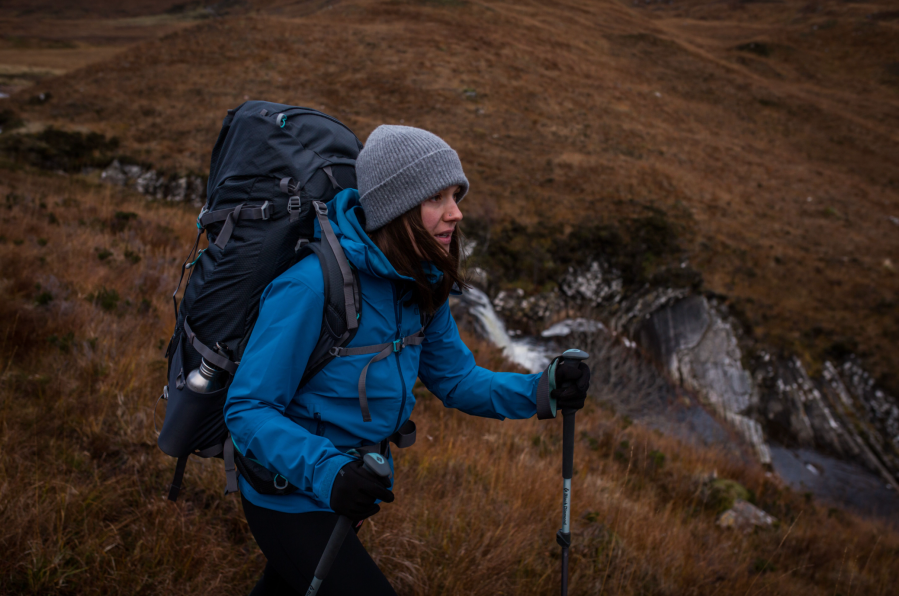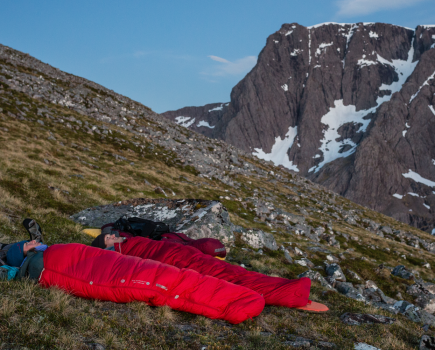Packs come in many styles and sizes. Finding out how to fit and choose a hiking backpack that’s right for you depends first on how much you’ll be carrying and how well a pack fits.
Main image: A gear test of hiking backpacks in action on the Snowdon massif. | Credit: Benjamin Cannon.
How to fit and choose a backpack for day trips
For light loads around 5-6kg (11-13lbs) careful fitting isn’t needed. A pack with padded shoulder straps and a padded back is all that’s needed. As long as the base of the pack doesn’t come much below the base of your spine when the shoulder straps are tightened the pack should be fine. Such packs are designed for day hiking – daypacks – and have volumes from 15-35 litres.
- Learn more about the different types of backpack.
How to fit and choose a backpack for multi-day excursions
Once you’ll be carrying gear for camping larger packs are needed and the fit becomes important. A properly fitted and adjusted pack should mean most of the weight is carried on your hips not your shoulders. To do this the back length must be correct. Too short and the hipbelt will ride too high and won’t support much weight without cutting painfully into your stomach. Too long and the top of the shoulder straps will be above your shoulders, making the pack unstable, or the hipbelt too low to fasten tightly. In either case the pack will be uncomfortable to carry.
Because the length is so important many packs come in different sizes while others have adjustable backs that let you move the shoulder straps, and sometimes the hipbelt, up and down the back. A few packs have both features. You can read about the best backpacking packs, as judged by The Great Outdoors’ expert gear reviewers.
How to fit a backpack
To find the right fit packs should be tried on fully loaded. It’s worth taking time to do this. A comfortable pack makes a huge difference to the enjoyment of a backpacking trip.

Iona Andean on a backpacking trip in the Grey Corries. Credit: Jessie Leong.
Most packs come with specific fitting instructions and it’s always worth following these.
These are the basics:
- The key for the correct fit is the length of your back, measured from the base of the neck to the upper hipbone (technically from the seventh cervical vertebra to the top of the iliac crest). Having someone measure your back length with a flexible tape measure is the best way to find this. Your actual height is not important – some people have long legs and short backs, other have short legs and long backs.
- Packs generally come in 5 centimetre/2-inch increments. If you’re on the edge of two sizes it’s best to try both on to see which feels best.
- The padded section of the shoulder straps should curve under your arms leaving only a relatively short length of webbing for adjustment. How far apart the shoulder straps are at the top matters. Too wide and the straps can feel as though they’re falling off. Some packs have shoulder straps that can be adjusted for width. Women’s packs generally have shoulder straps that are closer together at the top than men’s packs.
- If the back length is right the hipbelt should wrap round your hips with the upper edge about 2.54 centimetres/1 inch above your hipbones so that the weight is carried comfortably on your hips. The padded sections of the belt should come round the side of your hips to help spread the load. Some packs have hipbelts that allow you to adjust the length of the padded sections. Many hipbelts are shaped so they curve over your hips.
- Most packs have narrow straps that rise from the upper shoulder straps to the top of the pack back. These load lifter or top tension straps are designed to pull the load in over your shoulders to increase stability and to lift the shoulder straps off the top of the shoulders and transfer the weight to the collarbones. Loosening and tightening these straps while walking can adjust the weight between the hipbelt and the shoulder straps. To be effective load lifter straps should rise at an angle of around 45 degrees.
- The final item to adjust is the sternum strap that runs across the top of the chest. This pulls the shoulder straps inwards and increases stability. Sternum straps can be moved up and down the shoulder straps. To be effective and comfortable they should sit high up, just below your neck. They’re not essential but can be very useful when scrambling or hiking on rough terrain.
Only when you have a pack that fits your back should the features of the pack be considered. It doesn’t matter what pockets, compartments, straps or other features a pack has if it doesn’t fit.
READ MORE: Once you’ve learned how to fit and choose a backpack for hiking, further your skills with how to pack a backpack








